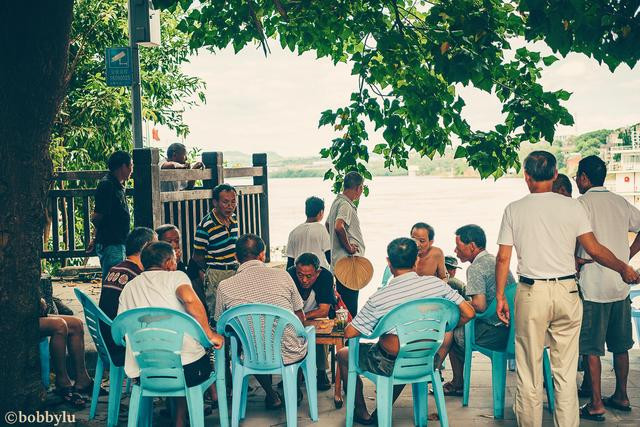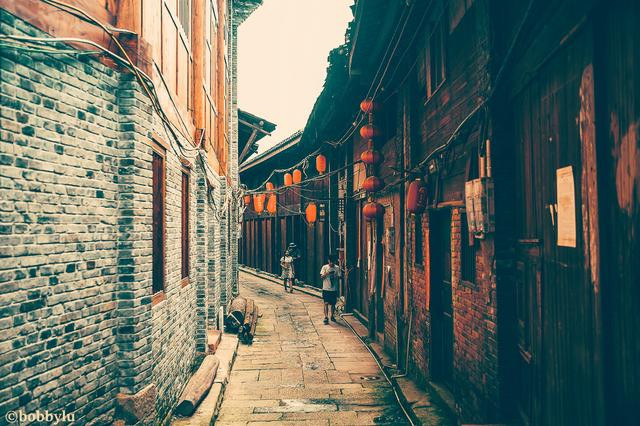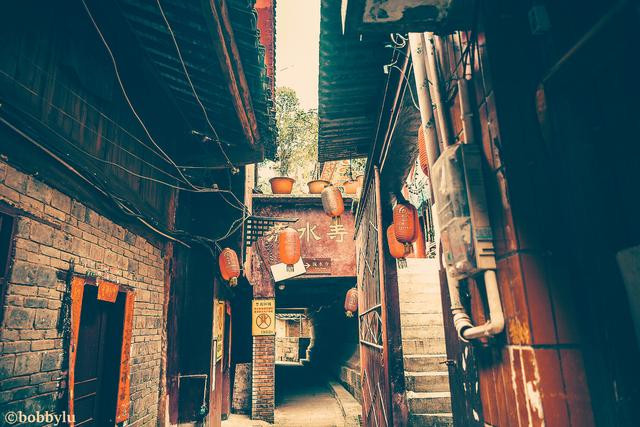Not envious of the dazzling lights, only fond of the morning mist and smoke, savoring the ancient flavors in the two most beautiful ancient towns of Jiangjin
Small bridges, flowing water, homes, blue bricks, white walls, and black tiles Those with slightly similar scenery dare to call themselves ancient towns, regardless of whether they are new or old. However, the roughly similar landscape with little cultural connotation, coupled with homogeneous content (tourism products, snacks), makes people exclaim that they are deceived and boring while wandering around! However, in Jiangjin, Chongqing, I stumbled upon two of the most beautiful ancient towns that are relatively unknown but can be savored carefully - Zhongshan Ancient Town and Baisha Ancient Town.

The title of 'the most beautiful ancient town' is not self proclaimed by others. Zhongshan Ancient Town, commonly known as Sanhe Chang or Longdongchang, has been approved as a historical and cultural town since 2002. Afterwards, it was also named the Town of Couplets in Chongqing, and until 2015, Zhongshan Ancient Town was awarded the title of "Third Most Beautiful Town in China". Zhongshan Ancient Town is located on the banks of the Sunxi River in the southern part of Jiangjin District, Chongqing. It is surrounded by mountains and water, but also adjacent to the city, nearly 50 kilometers away from Jiangjin. However, it is only over 90 kilometers from the center of Chongqing to here.


When I first arrived at Zhongshan Ancient Town, I didn't even see the archway or gate of the town, which shows how much I have been wandering around. After passing through a wooden corridor along the river, I pulled my luggage and walked on the uneven stone street, which was not wide and had shops on both sides. Later on, it was discovered that on one side of the river, all the buildings were wooden stilted houses, while on the other side, small buildings with almost identical old brick and wood structures were connected in a row. The tightness of the houses is almost such that they are adjacent to each other and there are few visible corridors. After a brief rest, I eagerly plunged into the streets and alleys under the gradually dim light

The afterglow of the sunset is almost completely engulfed by the night, making it even darker in the streets and alleys where there is not much light during the day, and there is little public lighting on the main streets and alleys. Occasionally, the lights of the shops are projected onto the streets and alleys, with a warm orange hue interspersed with white fluorescent lights. So, taking advantage of this opaque tone, I started my street sweeping shoot with my camera. I am eagerly looking forward to capturing something, but as for what I really want to capture, I may not even know myself.

Passing by the first shop with lights on, the food in a large basket placed at the entrance attracted me. It looks like rice cake, but upon closer inspection inside the store, there are several circular baskets hanging on the walls with the red words "Shiban Baba" written on them. For most of the snacks in ancient towns, I have long since given up my hope. After all, Stinky tofu and big sausages in some places have spread all over the ancient towns all over the country, and they dare to call themselves authentic and authentic. And this stone slab cake, not to mention having eaten it before, even the name is heard for the first time. Must try local specialties!


So I bought one to taste, as I had imagined. Glutinous rice was the main ingredient, followed by sugar or bean paste as the filling. As for the method, it is said that the process is complicated, and it is finally made with a hammer in a stone groove. Not to mention anything else, with just a few simple materials and pure handmade techniques, the taste of the stone slab cake can be made, but it is also simple and sweet with a flavor that can definitely be called thought-provoking and worth savoring. Perhaps this is the kind of hometown flavor that people often talk about, or the ancient flavor that foodies can't forget

It is obvious that from the stone slab cakes I bought from this store, I can feel that the living attitude of the indigenous people in Zhongshan Ancient Town and the business they rely on for survival seem very simple. After receiving the money, they continue to play cards, regardless of whether I am standing at the door, walking or not. The children of the shop owner's family are still staring blankly at the tourists passing by the door. It seems like nothing has happened, no one has come or gone



Not every shop in the streets and alleys has its door open, as can be seen from the intermittent lights in front of the door, which are flickering; Some doors and windows are closed; Some are open and remote; Some shops are brightly lit but the owner cannot be seen; Some shop or stall owners look at their phones alone or do their own things without looking up. Even the little cat that lives in the house is too lazy to turn around and look at me, or simply walk away quietly after a glance. Such a small cat is surprisingly indifferent to strangers, which shows how leisurely and comfortable the people in this ancient town are, and they are never easily disturbed by outsiders.

But in fact, almost all the shop owners are very enthusiastic. Just like the slate cake I just bought, the shop owners who should say and ask have told you everything in a conventional way, and the rest is for you to taste the delicious food for yourself. In those few words, there is a sense of duty and understated enthusiasm. Perhaps this is just a normal mindset


For tourists, around 8 pm may be the time for dinner after sightseeing, but for locals, it seems like they have already started their leisure time after dinner. Some aunties are doing fitness exercises in the room behind the wooden door, while others are lying on a lounge chair with a radio on their stomach, holding the radio with one hand and a fan with the other hand It's a great cultural scene, but I still dare not press the shutter button in a sneaky way. So, I just looked around like Liu Laolao entered the Grand View Garden, which satisfied my curiosity



And the most diligent foodies are always able to warmly greet the few passing tourists in the streets and alleys. Even if you just take a photo of the good preserved meat or stop to look at their work, they will temporarily put aside their work and ask you with a smile if you want to eat. From their accents, it can be inferred that they are all authentic locals or Chongqing people. Even on the whole street, I haven't heard anyone with a foreign accent doing business here. From this, it can be seen that there have not been too many commercial and secular factors interfering here. Perhaps it's not due to holidays, although there aren't many tourists on the streets and diners are rarely seen dining in restaurants. But it's not as fireworks as imagined, but in this narrow street, everything is filled with


There are no signs of aging on the door panels, windows, signs, or flags, although the uneven bluestone road is not as shiny or reflective as the footsteps of pedestrians in Lijiang Ancient Town. But the pure primitive atmosphere in the entire ancient town, and although I haven't seen the smoke rising from every household's cooking, it gives people a strong feeling of smoke and fire. Of course, there is also the indifference that the people here naturally display.
I'm glad I didn't finish dinner and rushed back to the hotel to rest, otherwise I would have missed out on such an ordinary night in Zhongshan Ancient Town, Jiangjin. The streets and alleys were full of ancient morning flavor under the dim yellow light

Furthermore, when I had the opportunity again and went to Baisha Town, also located in Jiangjin, the next day, I didn't hesitate to choose to go there in the light rain. It was said to be light rain, but in the cloudy weather with occasional swaying of the sun, a few drops occasionally dripped down. Unconsciously, we arrived at Baisha Town, the national first deep-water port in the upper reaches of the Yangtze River, which is known as the "Tianfu Famous Town", "Chuandong Cultural Town" and "Little Hong Kong".


As soon as I stepped down the high steps of the nearby dock, a strong sense of life filled my eyes. Under the big tree, almost all the tables and chairs were covered with cloth, and dozens of middle-aged and elderly people were sitting around the table playing cards under the shade of the trees. I carry a big bag of photography equipment on my back and a camera in my hand. Just looking at it makes me feel cool and comfortable, and my eyes are so hungry. Quickly press a few buttons and hurriedly walk towards the direction of the ancient town. In fact, I don't know exactly where to go. With the guidance of a friend who was familiar with the road, I walked a muddy path and climbed up the stairs before entering Baisha Town, which is currently under construction in some areas.


Baisha Town is actually a narrow town built along the river, and it is said to have the tallest stilt houses in the country. Gai Yin is a suspended building built on the banks of the Yangtze River. During periods of high tide or abundant rainfall, it is believed that this height is not difficult to understand. Nowadays, the base materials of these so-called stilt houses have been replaced with brick, stone or cement poured materials instead of wooden ones, which has greatly improved their strength, but still looks a bit scary! But to be honest, it's quite proud to live in such a hanging house that seems to be located in a dangerous terrain, but actually steps on the banks of the Yangtze River, and can always have a far sighted view of the rolling Yangtze River by leaning on the railing, isn't it!

However, due to the tight schedule and urgent tasks, the tourism and filming of Baisha Town were completed in an almost urgent manner. As a result, we were unable to carefully explore what Baisha looked like, the numerous and irreplaceable historical and ancient buildings, as well as the Chaotianzui Pier and some well preserved side alleys. We only wandered around and filmed some materials in a relatively complete main street and alley, feeling a little relieved in regret


During the day, I didn't see many people in Baisha Town. Perhaps it's because the indigenous people are all working, or maybe it's because the town is undergoing overall renovation. In short, except for a few elderly people who occasionally appear in front of their homes to cool off in the streets and alleys, most of the streets and alleys I have visited have not seen many people. But from the traces of time in the architecture, it can be seen that these are indeed some old houses with a long history. As for the reputation of "Little Hong Kong", perhaps one can see some traces of the old streets of Hong Kong from the entire main street and even from the well connected steps up and down. In addition, the once convenient water and land transportation here has led to economic prosperity, and perhaps this is how the name "Little Hong Kong" came about.



However, now, everywhere here is showing signs of decay and depression. But perhaps this is only temporary, and the ongoing repairs may be precisely for this reason. However, for photography enthusiasts, this is indeed a great place to capture human or environmental portraits. Find a model, bring a few outfits or props, and you can shoot a set of retro style photos of the Republic of China anytime, anywhere!


Although Baisha Town has less smoke and vitality compared to Zhongshan Ancient Town. But the rich ancient flavor and authentic ecological atmosphere are rarely seen in many ancient towns I have visited. These two ancient towns, just like the locally handcrafted stone slabs of rice cake, may seem simple and complex, but they have a profound and unforgettable taste when eaten... It is rare to have such a fair evaluation as "the most beautiful town in China". Although both ancient towns are nestled by mountains and waters, and also adjacent to bustling cities, they give people a feeling of comfort, tranquility, and comfort that they do not envy the dazzling lights and the solitary love for the evening mist and morning smoke
Previous Article:Lianglukou | The City Light of Yuzhong, the Mother City of Chongqing
Next Article:My Journey to Chongqing
